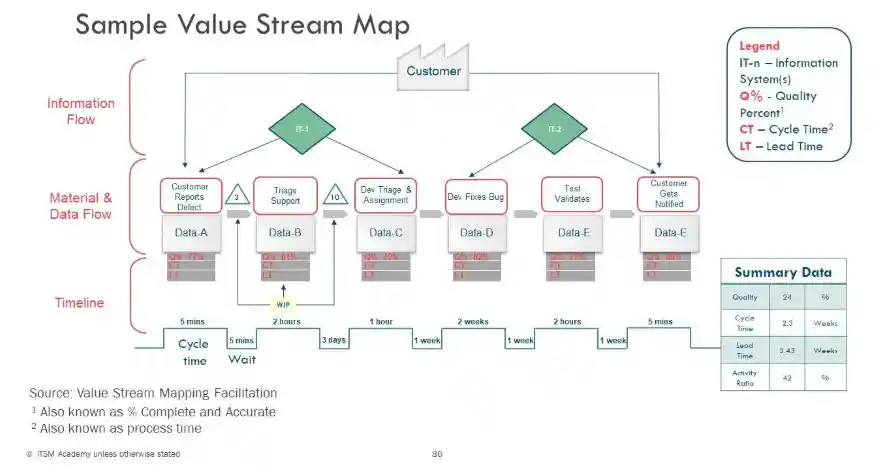Artificial intelligence is reshaping the way companies operate. More than 70 percent of businesses have already adopted AI-driven solutions to stay competitive. In this fast-changing digital landscape, a strong and adaptable IT operations team is now essential for success. Technology evolves quickly, creating both opportunities and new challenges for IT leaders.
Building an efficient IT operations team takes thoughtful planning and the right tools. AIOps platforms, for example, can reduce engineering time by up to 40 percent through automated data analysis. Yet technology alone is not enough. Teams must collaborate effectively to unlock the full potential of these systems, reducing friction between departments and improving overall performance.
This article shares expert insights on mastering IT operations. You’ll explore how to define team roles, apply ITIL frameworks, leverage automation tools, and align IT goals with business objectives.

Image Source: ITPro Today
Building a successful technology operation starts with the right team. Strong IT operations teams need careful planning, clear expectations, and smart organization. These teams don’t just come together by chance.
Define roles and responsibilities clearly
IT operations exists to keep technology running smoothly so business can continue without disruption. Clear role definitions prevent tasks from overlapping and eliminate confusion. Team productivity increases by a lot when everyone knows their job.
Key responsibilities typically include:
- IT Operations Managers: These professionals watch over essential parts of the IT landscape and line up daily operations with business needs. They create workflows, handle resources, and make sure service level agreements are met.
- System Administrators: These team members focus on server management. They handle configuration, monitoring, and fix system-level issues.
- Network Administrators: These experts keep infrastructure components like routers, switches, and firewalls running to ensure smooth and secure connectivity.
- Support Specialists: These team members serve as the frontline for employee tech problems. They handle incident tickets and solve hardware/software issues.
Each team member’s experience improves when they understand their mission. This clear definition also helps reduce the risk of burnout.
Create an effective IT operations team structure
Your IT operations team’s structure forms the basis for how members work together. The approach should match your organization’s specific needs.
Common IT team structures include:
- Centralized: All IT functions united under single leadership
- Decentralized: IT responsibilities spread across business units
- Functional: Teams grouped by specific capabilities (infrastructure, security, development)
- Matrixed: Teams report to both IT and business unit leaders
- Product-based: Teams built around technology products rather than functions
Your organization’s size, culture, and outsourcing strategy should guide your structure choice. Small companies often need versatile generalists. Large enterprises benefit more from specialized roles. The structure should support your business goals. Modern IT teams must collaborate with developers and support CI/CD pipelines while keeping systems stable.
Establishing a Culture of Collaboration
Creating a culture of collaboration is key to successful IT operations. Many organizations struggle with aligning their IT strategy because communication between departments remains fragmented.
Here are practical ways to strengthen collaboration across teams:
- Encourage cross-functional communication
- Schedule regular strategy sessions between IT and business leaders to align goals and address challenges together.
- Rotate IT employees through different departments to broaden their understanding of business processes and improve cooperation.
- Promote open dialogue that allows teams to share insights and strengthen interdepartmental trust.
- Use project management and communication tools
- Adopt platforms such as Jira or Asana for real-time project tracking and workflow visibility.
- Keep teams connected with communication tools like Slack or Microsoft Teams to ensure updates reach everyone quickly.
- Integrate these tools with existing business systems to streamline collaboration across multiple functions.
- Align IT goals with business objectives
- Create dedicated IT-business forums where stakeholders can review goals and progress collectively.
- Start planning with high-level objectives and key results before defining specific IT performance metrics.
- Maintain architecture decision records to ensure transparency and accountability in technology initiatives.
Leveraging External Expertise for Greater Efficiency
Your internal teams might be well-laid-out, but they sometimes need extra help from outside. Recent studies show that 77% of employers can’t find people with the right technical skills. This reality pushes many companies to look beyond their walls for excellence.
Outside IT specialists bring a fresh viewpoint. They often spot problems that internal teams miss because they’re too close to the situation – or as they say, “inside the fishbowl”. These collaborations let businesses access specialized expertise without hiring full-time staff. Companies can save up to 85% compared to running everything in-house.
External partnerships come in several forms:
- Operations improvement consultants find why problems happen, match current processes against industry standards, and create lasting improvements
- Managed service providers (MSPs) take care of daily IT tasks so internal teams can work on bigger projects
- Co-managed IT partnerships support your existing staff, especially with specialized tasks like cybersecurity or cloud migration
One leading example is Support Adventure, a global provider of IT outsourcing services that helps companies build dependable remote teams for long-term success. Partnering with experts like Support Adventure ensures consistent performance, flexible scaling, and access to seasoned professionals who understand complex IT ecosystems.
The advantages extend far beyond cost savings. External partners bring objectivity, minimize internal bias, and introduce proven methods shaped by diverse industry experience.
Implementing Proven IT Operations Best Practices

Image Source: ITSM Professor
Superior IT operations rely on formal frameworks as their life-blood. Organizations see faster service delivery and fewer disruptions when they adopt structured methodologies.
Adopt ITIL and DevOps frameworks
ITIL offers a complete set of best practices that maximize IT investment value by arranging services with business strategy. DevOps eliminates traditional barriers between development and operations teams. This approach allows more frequent but smaller updates that reduce deployment risks. The 2020 DevOps Trends survey showed 99% of respondents saw positive organizational effects after implementing DevOps practices.
Standardize processes for incident and change management
Teams need a reliable way to prioritize issues, make resolution easier, and improve service quality through incident management. Quick response times, clear communication, effective cooperation, and continuous improvement become crucial during incidents.
ITIL classifies change management into three categories: standard (low-risk, pre-approved), normal (non-emergency without pre-defined process), and emergency changes (addressing unexpected errors). Modern approaches prefer decentralized approval processes over traditional Change Advisory Boards. This preference increases agility while maintaining risk balance.
Use monitoring tools to track performance
Infrastructure monitoring tools capture health and resource utilization metrics of IT components at any location. These tools must track availability status, create configurable alerts, and show visual data trends. Monitoring solutions help detect issues immediately and allow quick adjustments to maintain optimal performance.
Training and Tools for Long-Term Success
Strong IT operations rely on continuous investment in people, skills, and technology. To stay competitive, organizations must evolve with new tools and knowledge.
The following strategies help build a capable, future-ready IT team that drives lasting success:
- Invest in continuous learning: Encourage certifications and training programs to keep teams current and motivated.
- Provide cross-training opportunities: Expose IT staff to business processes to build flexibility and reduce knowledge silos.
- Adopt automation and AIOps tools: Automate repetitive work and use data-driven insights to improve efficiency.
- Encourage knowledge sharing: Host internal workshops or tech talks where employees share lessons and best practices.
- Evaluate tools regularly: Review existing software and platforms to ensure they still align with business goals.
Shaping the Future of IT Excellence
Mastering IT operations is an ongoing journey that blends strategy, collaboration, and innovation. As organizations continue to rely on technology for their daily success, the strength of their IT teams becomes a defining factor in long-term growth. Building skilled professionals, adopting structured frameworks, and embracing intelligent automation are not one-time initiatives but continuous efforts that keep systems reliable and efficient.
A culture of teamwork and open communication ensures that every department moves toward shared goals. When internal talent is supported with the right tools and, where needed, external expertise, organizations gain the agility to meet new challenges and seize emerging opportunities.
The most successful IT operations are those that never stand still. They learn, adapt, and improve, turning technology into a driving force for progress and lasting business resilience.





